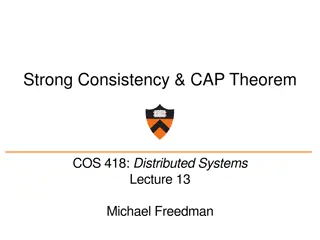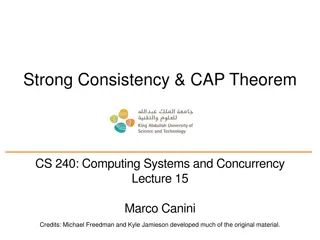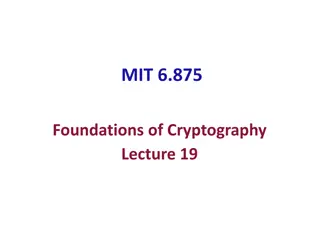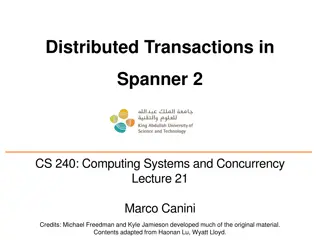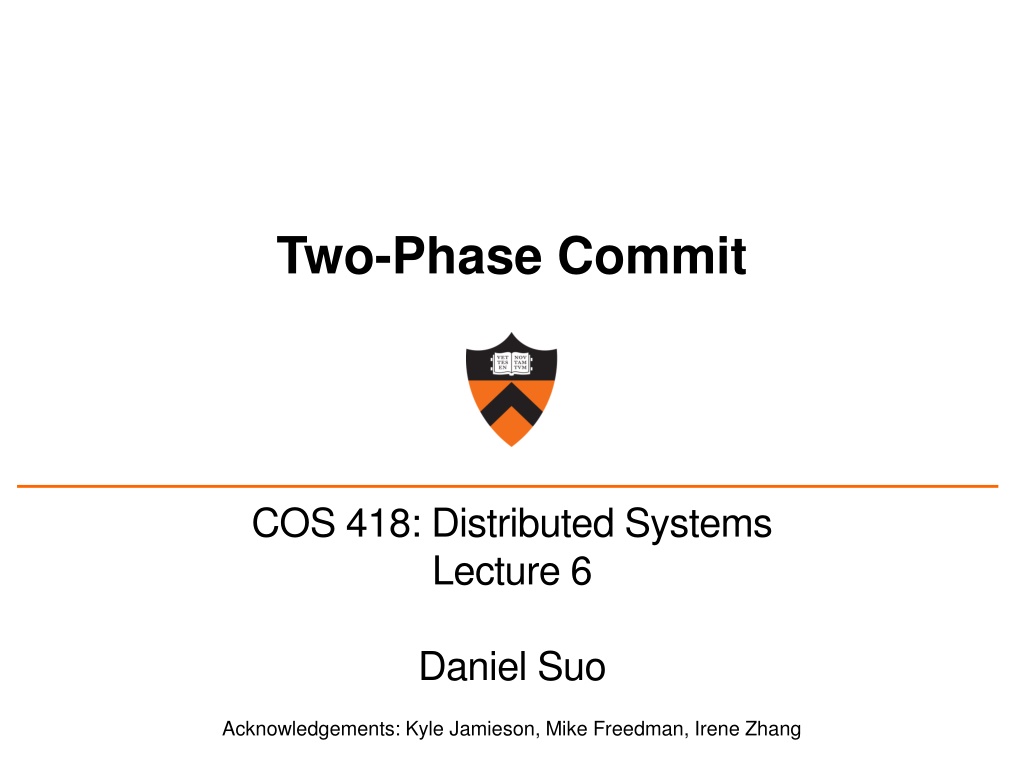
Understanding Fault Tolerance in Distributed Systems
Explore fault tolerance in distributed systems, covering topics such as detecting errors, containing errors, masking failures, and reasoning about fault tolerance. Learn about safety and liveness properties essential for reliable system design.
Download Presentation

Please find below an Image/Link to download the presentation.
The content on the website is provided AS IS for your information and personal use only. It may not be sold, licensed, or shared on other websites without obtaining consent from the author. If you encounter any issues during the download, it is possible that the publisher has removed the file from their server.
You are allowed to download the files provided on this website for personal or commercial use, subject to the condition that they are used lawfully. All files are the property of their respective owners.
The content on the website is provided AS IS for your information and personal use only. It may not be sold, licensed, or shared on other websites without obtaining consent from the author.
E N D
Presentation Transcript
Two-Phase Commit COS 418: Distributed Systems Lecture 6 Daniel Suo Acknowledgements: Kyle Jamieson, Mike Freedman, Irene Zhang
Plan Fault tolerance in a nutshell Safety and liveness Two-phase commit 2
What is fault tolerance? Building reliable systems from unreliable components Three basic steps 1. Detecting errors: discovering the presence of an error in a data value or control signal 2. Containing errors: limiting how far errors propagate 3. Masking errors: designing mechanisms to ensure a system operates correctly despite error (and possible correct error) 4
Why is fault tolerance hard? Failures Propagate Say one bit in a DRAM fails it flips a bit in a memory address the kernel is writing to... ...causes big memory error elsewhere, or a kernel panic... ...program is running one of many distributed file system storage servers... ...a client can t read from FS, so it hangs. 5
So what to do? 1. Do nothing: silently return the failure 2. Fail fast: detect the failure and report at interface Ethernet station jams medium on detecting collision 3. Fail safe: transform incorrect behavior or values into acceptable ones Failed traffic light controller switches to blinking-red 4. Mask the failure: operate despite failure Retry op for transient errors, use error-correcting code for bit flips, replicate data in multiple places 6
Masking failures We mask failures on one server via Atomic operations Logging and recovery In a distributed system with multiple servers, we might replicate some or all servers But if you give a mouse some replicated servers She s going to want a way to keep them all consistent in a fault tolerant way 7
Reasoning about fault tolerance This is hard! How do we design fault-tolerant systems? How do we know if we re successful? Often use properties that hold true for every possible execution We focus on safety and liveness properties 9
Safety Bad things don t happen No stopped or deadlocked states No error states Examples Mutual exclusion: two processes can t be in a critical section at the same time Bounded overtaking: if process 1 wants to enter a critical section, process 2 can enter at most once before process 1 10
Liveness Good things happen eventually Examples Starvation freedom: process 1 can eventually enter a critical section as long as process 2 terminates Eventual consistency: if a value in an application doesn t change, two servers will eventually agree on its value 11
Often a tradeoff Good and bad are application-specific Safety is very important in banking transactions May take some time to confirm a transaction Liveness is very important in social networking sites See updates right away (what about the breakup problem ?) 12
Motivation: sending money send_money(A, B, amount) { Begin_Transaction(); if (A.balance - amount >= 0) { A.balance = A.balance - amount; B.balance = B.balance + amount; Commit_Transaction(); } else { Abort_Transaction(); } } 14
Single-server: ACID Atomicity: all parts of the transaction execute or none (A s decreases and B s balance increases) Consistency: the transaction only commits if it preserves invariants (A s balance never goes below 0) Isolation: the transaction executes as if it executed by itself (even if C is accessing A s account, that will not interfere with this transaction) Durability: the transaction s effects are not lost after it executes (updates to the balances will remain forever) 15
Distributed transactions? Partition databases across multiple machines for scalability (A and B might not share a server) A transaction might touch more than one partition How do we guarantee that all of the partitions commit the transactions or none commit the transactions? 16
Two-Phase Commit (2PC) Goal: General purpose, distributed agreement on some action, with failures Different entities play different roles in the action Running example: Transfer money from A to B Debit at A, credit at B, tell the client okay Require both banks to do it, or neither Require that one bank never act alone This is an all-or-nothing atomic commit protocol Later will discuss how to make it before-or-after atomic 17
Straw Man protocol 1. C TC: go! Client C go! Transaction Coordinator TC Bank A B
Straw Man protocol 1. C TC: go! Client C A: debit $20! B: credit $20! C: okay 2. TC TC TC go! okay Transaction Coordinator TC A, B perform actions on receipt of messages Bank A B
Reasoning about the Straw Man protocol What could possibly go wrong? 1. Not enough money in A s bank account? 2. B s bank account no longer exists? 3. A or Bcrashes before receiving message? 4. The best-effort network to B fails? 5. TC crashes after it sends debit to A but before sending to B? 20
Safety versus liveness Note that TC, A, and B each have a notion of committing We want two properties: 1. Safety If onecommits,no one aborts If oneaborts,no one commits 2. Liveness If no failures and A and B can commit, action commits If failures, reach a conclusion ASAP 21
A correct atomic commit protocol 1. C TC: go! Client C go! Transaction Coordinator TC Bank A B
A correct atomic commit protocol 1. C TC: go! Client C 2. TC A, B: prepare! Transaction Coordinator TC prepare! prepare! Bank A B
A correct atomic commit protocol 1. C TC: go! Client C 2. TC A, B: prepare! P: yes or no 3. A, B Transaction Coordinator TC Bank A B
A correct atomic commit protocol 1. C TC: go! Client C 2. TC A, B: prepare! P: yes or no 3. A, B Transaction Coordinator TC A, B: commit! or abort! 4. TC TC sends commit if both say yes TC sends abort if either say no commit! commit! Bank A B
A correct atomic commit protocol 1. C TC: go! Client C 2. TC A, B: prepare! okay P: yes or no 3. A, B Transaction Coordinator TC A, B: commit! or abort! 4. TC TC sends commit if both say yes TC sends abort if either say no 5. TC C: okay or failed Bank A B A, B commit on receipt of commit message
Reasoning about atomic commit Why is this correct? Neither can commit unless both agreed to commit What about performance? 1. Timeout: I m up, but didn t receive a message I expected Maybe other node crashed, maybe network broken 2. Reboot: Node crashed, is rebooting, must clean up 27
Timeouts in atomic commit Where do hosts wait for messages? TCwaits for yes or no from A and B TChasn t yet sent any commit messages, so can safely abort after a timeout But this is conservative: might be network problem 1. We ve preserved correctness, sacrificed performance A and Bwait for commit or abort from TC If it sent a no, it can safely abort(why?) If it sent a yes, can it unilaterally abort? Can it unilaterally commit? 2. A, B could wait forever, but there is an alternative 28
Server termination protocol Consider Server B (Server A case is symmetric) waiting for commit or abort from TC Assume B voted yes (else, unilateral abort possible) B A: status? A then replies back to B. Four cases: (No reply from A): no decision, B waits for TC Server A received commit or abort from TC: Agree with the TC s decision Server Ahasn t voted yet or voted no: both abort TCcan t have decided to commit Server A voted yes: both must wait for the TC TC decided to commitif both repliesreceived TC decided to abort if it timed out 29
Reasoning about the server termination protocol What are the liveness and safety properties? Safety: if servers don t crash, all processes will reach the same decision Liveness: if failures are eventually repaired, then every participant will eventually reach a decision Can resolve some timeout situations with guaranteed correctness Sometimes however A and B must block Due to failure of the TC or network to the TC But what will happen if TC, A, or Bcrash and reboot? 30
How to handle crash and reboot? Can t back out of commit if already decided TC crashes just after sending commit! A or B crash just after sending yes If all nodes knew their state before crash, we could use the termination protocol Use write-ahead log to record commit! and yes to disk 31
Recovery protocol with non-volatile state If everyone rebooted and is reachable, TC can just check for commit record on disk and resend action TC: If no commit record on disk, abort You didn t send any commit! messages A, B: If no yes record on disk, abort You didn t vote yes so TCcouldn t have committed A, B: If yes record on disk, execute termination protocol This might block 32
Two-Phase Commit This recovery protocol with non-volatile logging is called Two-Phase Commit (2PC) Safety: All hosts that decide reach the same decision No commit unless everyone says yes Liveness:If no failures and all say yes then commit But if failures then 2PC might block TC must be up to decide Doesn t tolerate faults well: must wait for repair 33
Assignment 2 Due October 19 Wednesday topic Consensus I: FLP Impossibility and Paxos 34
Two-phase commit failure scenarios 35
What if participant fails before sending response? 36
What if participant fails after sending vote 37
What if coordinator fails before sending prepare? 39
What if coordinator fails after sending prepare? 40
What if coordinator fails after receiving votes 41
What if coordinator fails after sending decision? 42
What happens if we dont have a decision? 44




